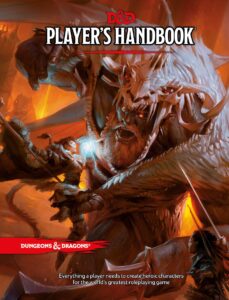Tabletop Roleplaying Games (TTRPG) exist in a unusual place. To quote Gary Gygax, “Unlike Chess… the rules are not cut and dried.” (AD&D Players Handbook, 1978). That is to say, Dungeons & Dragons and its ilk rely on a base set of rules and then on the referee’s judgment to fill in the gaps (or even interpret the rules).
So, to define things, a “rule” is something written down for how the game works, on which everyone agrees. A “ruling” is what an individual referee decides and can vary from table to table.
Different TTRPGs have different approaches to how much they explain instead of relying on the referee’s judgment.
The Horses of Design
For instance, in a recent D&D 5E game, a pack of wolves attacked a horse-riding party. These were not warhorses, but instead, normal horses untrained for war.
5E has no rule as to how the horses react. However, in 3E, there was a rule. (To control a non-combat-trained horse in a battle, you needed to make a DC 20 Ride check).
If in 5E, I wanted to have the horses shy away from the wolves and require a check – perhaps Animal Handling – to control them, that would be a ruling.
However, this was one of only a few times in seven years of running 5E that the situation came up. And that is a reason for the rules not including what happens: It is too infrequent. It is tremendously easy to design to cover any situation that comes to mind. However, every additional one is a burden on the referee and players to remember.
I once heard it said of Advanced Squad Leader – a tremendously complex game – that no one has ever played a game of it correctly. Some rules will always be forgotten or misinterpreted. That is the burden of a complex game, especially with many rules that are rarely relevant.
Magical or Unmagical?
Contrariwise, having almost no rules for a game puts it on the referee to devise rulings for situations, which can be a pain. And if the situation keeps coming up, the GM needs to make sure they are consistent in how they rule.
One of the worst arguments I saw recently about a D&D rule included the phrase “It is easy to tell what is magical in D&D.” Which is, of course, why Jeremy Crawford put a lengthy explanation in Sage Advice about what the game considers magical.
It’s easy for one person to determine if something is magical or not. It is not easy for two people to come to the same conclusion. And that’s why we have game rules and explanations – so two people have the same understanding of how the game works.
Not only that, but it creates a baseline. Because the other situation is that ONE person isn’t always consistent. One week, the referee rules that dragon breath is magical; the next, the referee rules that it isn’t, having forgotten what they ruled last week!
And this, of course, creates confusion for the players.
The Consistent Game
When a situation keeps turning up, the referee should rule the same way each time. That ruling they are making? That ruling should be a rule in the rulebook. The real trick is to know the difference: When is a situation so common that you need a rule for consistency, or when is it uncommon and can be omitted.
The line of Dungeons & Dragons that came from 3E and then branched off into Pathfinder generally takes the path of “rules for everything”. The rulebooks do not cover everything, but they try to pin down most of the common and uncommon areas of the game and explain how to handle them. Meanwhile, the current edition (5E) is a little less focused on that. Yes, it has quite a few rules, but it still depends more on the DM making rulings for situations.
You can very much see the difference in how the two handle skills. Pathfinder sets the DCs for each task that characters can attempt, while Dungeons & Dragons 5e mainly omits DCs, allowing the DM to determine them.
And then you have games like Original Dungeons & Dragons, which has only a few rules. Many other games that follow that path, especially some single-page RPGs!
Rules and the Game
The early days of Dungeons & Dragons don’t follow the “we want a rules light game” format, though. Instead, it includes more and more rules as supplements come out, with little thought about how they integrate into the game. In many cases, they were rulings for one situation that made it into a rulebook because they needed content but rarely came up in play.
You can see in a games’ rules what the designers consider essential to play. (Mostly). Consider that there are detailed rules on opening doors – usually stuck – in the original D&D game, and you see something that would be entirely out of place in, say, a Star Wars RPG.
There isn’t a correct answer to this. The joy of a TTRPG partly derives from the referee’s ability to make rulings, and the books do not constrain them. (Compare a TTRPG to any computer game RPG, where you are limited by what the programmers considered possible). However, it is worth considering the level of rules knowledge you want in a game and how many of the core play must be described by them for you to enjoy it!

